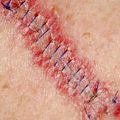Text to go here...
 Research on mice has revealed the process which limits the accumulation of excessive scar tissue.
Research on mice has revealed the process which limits the accumulation of excessive scar tissue.
Excessive tissue produced during the healing of chronic injuries can be damaging. For example, after a heart attack, scar tissue can build up in the heart and impair its ability to function properly. By studying scar tissue in mice, scientists found that fibroblast cells at wound sites stopped proliferating, entering the cell phase known as 'senescence'.
To find how the fibroblasts were being controlled, the team studied mice developed specifically to lack the gene coding for the protein CCN1. These mice produced fibroblasts which were not arrested in their cycle and proliferated to form excessive amounts of scar tissue. Only after the researchers placed CCN1 on the skin wound did the fibroblasts enter senescence and limit scar tissue accumulation.
Previously, cell senescence was though to occur only at tumour sites, to stop cancerous cells from reproducing. Now that cell proliferation at wound sites is known to be controlled by CCN1, scientists will be able to understand a wider range of conditions related to scarring.
Last edited: 11 January 2022 09:54




